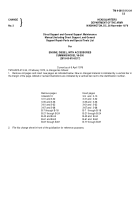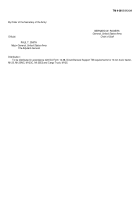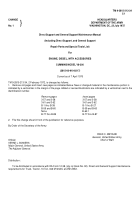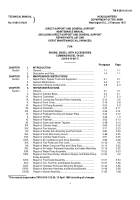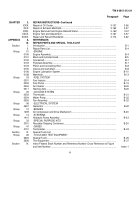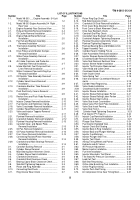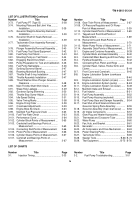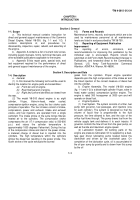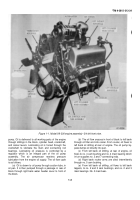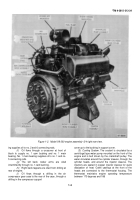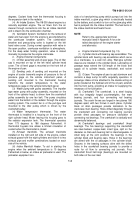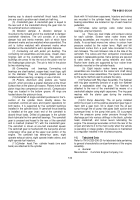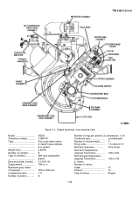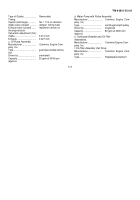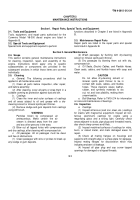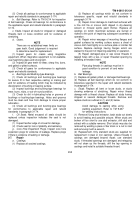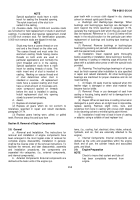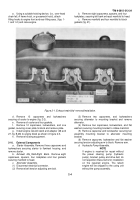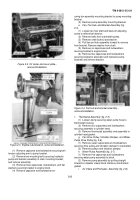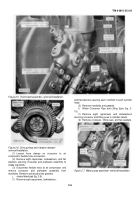TM-9-2815-213-34 - Page 12 of 192
*TM 9-2815-213-34
degrees. Coolant flows from the thermostat housing to
the expansion tank in the radiator.
(4)
Air Intake System.
The V8-300 diesel engine is a
naturally aspirated engine. The air flows from the air
cleaner through connections into the air intake manifold
and is drawn into the combustion chamber.
(5)
Ventilation System.
Ventilation for the removal of
water and fuel vapor from the engine is accomplished by
the crankcase breather system. The combination
breather and pressurizing valve is located on the left
hand valve cover. During normal operation with valve in
the open position, crankcase ventilation is atmospheric.
For the deep water fording operation, valve is closed
manually to pressurize the engine crankcase.
d.
Engine External Components.
(1)
Oil filler assembly and oil level gage.
The oil filler
cap is mounted on top of the left hand cylinder head
cover. The oil level gage is mounted on the front left of
the engine oil pan.
(2)
Sending units.
A sending unit mounted on the
engine oil cooler transmits engine oil pressure to the oil
pressure gage on the vehicle instrument panel. A
sending unit mounted to the thermostat housing
transmits the coolant temperature to the water
temperature gage on the vehicle instrument panel.
(3)
Water pump with pulley assembly.
The impeller
type water pump with pulley assembly, mounted on the
front of the cylinder head, is driven from the crankshaft
pulley assembly by one fan belt. The pump circulates
water from the bottom of the radiator through the engine
cooling system. The coolant fan is of the pull-type and
mounted to the idler pulley which is driven by the
crankshaft pulley.
(4)
Water temperature thermostat.
The water
thermostat is installed in a housing on the front of the
right cylinder head. Water leaving this housing goes to
the radiator expansion tank. The thermostat operates
from 173 degrees to 186 degrees Fahrenheit. A
thermostat by-pass line allows a limited circulation of
coolant when the thermostat is closed.
(5)
Exhaust manifolds.
The exhaust manifolds
installed on the right and left side of the engine, collect
exhaust gases from the eight cylinders and route it to two
exhaust pipe and muffler combinations located on each
side of the vehicle.
(6)
Intake Manifold Heater.
To aid in starting the
engine when the ambient temperature is 10 degrees
Fahrenheit or below, an intake air preheater is used. The
preheater equipment con-
sists of a hand-priming pump which pumps fuel into the
intake manifold, a glow plug which is electrically heated
by the battery, and a switch to turn on the glow plug while
fuel is pumped into the intake manifold. The fuel burns in
the intake manifold and heats the air.
NOTE
Refer to the, appropriate technical
manuals listed in Appendix A for a de-
tailed description of the engine starter
and alternator.
e.
Engine Internal Components
(fig.
13).
(1)
Cylinder block with bearing cap assemblies.
The
cylinder block with bearing cap assemblies which serve
as a crankcase, is a cast iron alloy. Wet-type cylinder
sleeves are installed in the cylinder block. Lubricating oil
passage ways extend the full length of the block and
supply oil to cylinder heads, crankshaft, and rocker
levels.
(2)
Oil pan.
The engine oil pan is cast aluminum and
contains a deep sump for 60% angularity operation. A
scavenge intake oil line attached to the double acting oil
pump (located at the flywheel end of the oil pan) extends
into the front sump, providing an intake for supplying the
necessary oil for lubrication.
(3)
Crankshaft.
The crankshaft, is a steel forging
with four integrally forged counterweights, five main
bearing journals, and four connecting rod bearing
journals. The crank throws are forged in two planes 180
degrees apart, with two throws in each plane. Cylinder
block oil drain passages provide lubrication to the
crankcase main bearing. Holes drilled diagonally through
the crankshaft and connecting rod bearing journals
provide direct passages for pressure lubrication of
connecting rod bearings. The crankshaft is statically and
dynamically balanced.
(4)
Crankshaft bearings and crankshaft thrust
bearings.
The five bearings supporting the crankshaft
are steel-backed, copper-lead, insert type, split on the
diameter so that each bearing half is interchangeable. A
small tang at the joint positions the bearings in the
cylinder block and bearing caps. Holes in the bearings
are alined with the oil passages in the cylinder block.
Grooves in the bearing surfaces aline with the drilled
holes in the crankshaft bearing journals to provide a
route for oil flow to connecting rod journals. Four
crankshaft thrust half-rings (bearings) are mounted on
both sides of the rear main
1-4
Back to Top

